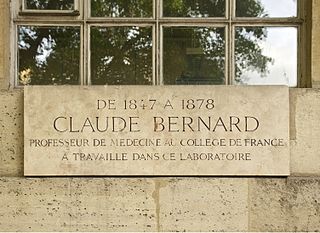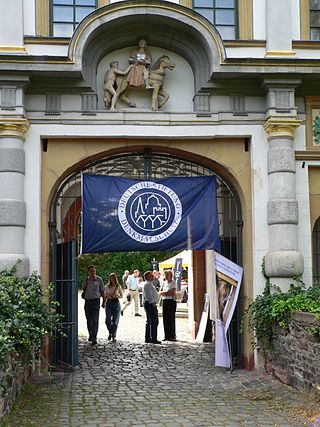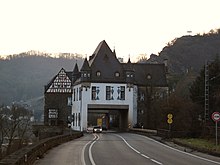
Historic preservation (US), built heritage preservation or built heritage conservation (UK) is an endeavor that seeks to preserve, conserve and protect buildings, objects, landscapes or other artifacts of historical significance. It is a philosophical concept that became popular in the twentieth century, which maintains that cities as products of centuries' development should be obligated to protect their patrimonial legacy. The term refers specifically to the preservation of the built environment, and not to preservation of, for example, primeval forests or wilderness.

A commemorative plaque, or simply plaque, or in other places referred to as a historical marker, historic marker, or historic plaque, is a plate of metal, ceramic, stone, wood, or other material, typically attached to a wall, stone, or other vertical surface, and bearing text or an image in relief, or both, to commemorate one or more persons, an event, a former use of the place, or some other thing. Many modern plaques and markers are used to associate the location where the plaque or marker is installed with the person, event, or item commemorated as a place worthy of visit. A monumental plaque or tablet commemorating a deceased person or persons, can be a simple form of church monument. Most modern plaques affixed in this way are commemorative of something, but this is not always the case, and there are purely religious plaques, or those signifying ownership or affiliation of some sort. A plaquette is a small plaque, but in English, unlike many European languages, the term is not typically used for outdoor plaques fixed to walls.

The Hague Convention for the Protection of Cultural Property in the Event of Armed Conflict is the first international treaty that focuses exclusively on the protection of cultural property in armed conflict. It was signed at The Hague, Netherlands, on 14 May 1954 and entered into force on 7 August 1956. As of July 2021, it has been ratified by 133 states.

Cultural heritage is the heritage of tangible and intangible heritage assets of a group or society that is inherited from past generations. Not all heritages of past generations are "heritage"; rather, heritage is a product of selection by society.

Heritage New Zealand Pouhere Taonga is a Crown entity that advocates for the protection of ancestral sites and heritage buildings in New Zealand. It was set up through the Historic Places Act 1954 with a mission to "...promote the identification, protection, preservation and conservation of the historical and cultural heritage of New Zealand" and is an autonomous Crown entity. Its current enabling legislation is the Heritage New Zealand Pouhere Taonga Act 2014.

European Heritage Days (EHD) is a joint action of the Council of Europe and the European Commission involving all 50 signatory states of the European Cultural Convention under the motto, Europe: a common heritage. The annual programme offers opportunities to visit buildings, monuments and sites, many of which are not normally accessible to the public. It aims to widen access and foster care for architectural and environmental heritage. These events are also known as Doors Open Days and Open Doors Days in English-speaking countries.

The Blue Shield, formerly the International Committee of the Blue Shield, is an international organization founded in 1996 to protect the world's cultural heritage from threats such as armed conflict and natural disasters. Originally intended as the "cultural equivalent of the Red Cross", its name derives from the blue shield symbol designed by Jan Zachwatowicz, used to signify cultural sites protected by the 1954 Hague Convention for the Protection of Cultural Property in Armed Conflict.
The European Route of Brick Gothic (EuRoB) is an association of cities, towns, regions, municipalities and institutions that have Brick Gothic buildings in their territory or have their headquarters in a Brick Gothic building. The network also includes several sponsors and cooperation partners.
The University Medical Center Hamburg-Eppendorf is the teaching hospital of the University of Hamburg and the largest hospital in Hamburg, Germany.

Jenisch House (Jenisch-Haus) is a country house in Hamburg built in the 19th century and an example of Hanseatic lifestyle and neoclassical architecture. As of 2008, Jenisch House is the home of the Museum für Kunst und Kultur an der Elbe. It is located within the Jenisch park in the Othmarschen quarter.

Cultural property, also known as cultural patrimony, comprises the physical items that are part of the cultural heritage of a group or society, as opposed to less tangible cultural expressions. They include such items as cultural landscapes, historic buildings, works of art, archaeological sites, as well as collections of libraries, archives, and museums.

The Swiss Agency for the Protection of Cultural Property defines measures to protect cultural property against damage, destruction, theft and loss. For this purpose, a legal basis has been established at the national level and international agreements have been made that oblige Switzerland to respect and support the protection of cultural property not only on its own territory but also on the sovereign territory of other state parties.

Heritage registers in Belgium include immovable heritage such as World Heritage Sites, and National heritage sites, but also intangible cultural heritage. The agency responsible for keeping and updating inventories of immovable heritage is dependent on the region, as is the name for the object, which is called Beschermd erfgoed, Biens classés or Kulturdenkmal depending on the language of the municipality of the location.

Kulturdenkmal is the official term to describe National Heritage Sites listed by law in German-speaking areas of Europe, to protect and spread awareness of cultural heritage.

The U.S. Committee of the Blue Shield (USCBS), founded in 2006, is the United States national committee of the Blue Shield. The Blue Shield was formed according to the provisions of the 1954 Hague Convention for the Protection of Cultural Property in the Event of Armed Conflict, which specifies a symbol of a blue shield for marking protected cultural property. The Blue Shield, of which USCBS is a member, is an organization of affiliated national committees from nations around the globe.

The Badischer Hof is the oldest hotel in Tauberbischofsheim. In 1733 it was built as the former Adelshof by the knight Anton Phillip von Fleischmann. Later, it was as a post office. In 1811 it received its present name: Badischer Hof. In 1894 a hall with large arched windows was added. In the hotel there is also a nostalgic movie theater. The house was obtained externally faithfully and since eight generations it belongs to the family Derr. It is a listed building.
Dankwart Guratzsch is a German journalist. He has made a name for himself above all as an architecture critic.

The Tag des offenen Denkmals is an annual event all over Germany. The day of action has been coordinated by the Deutsche Stiftung Denkmalschutz since 1993. Historic monuments are open to the public free of charge. It takes place on the second Sunday in September and attracts several million visitors each year. The largest cultural event in Germany is the contribution of the country to the European Heritage Days.


















